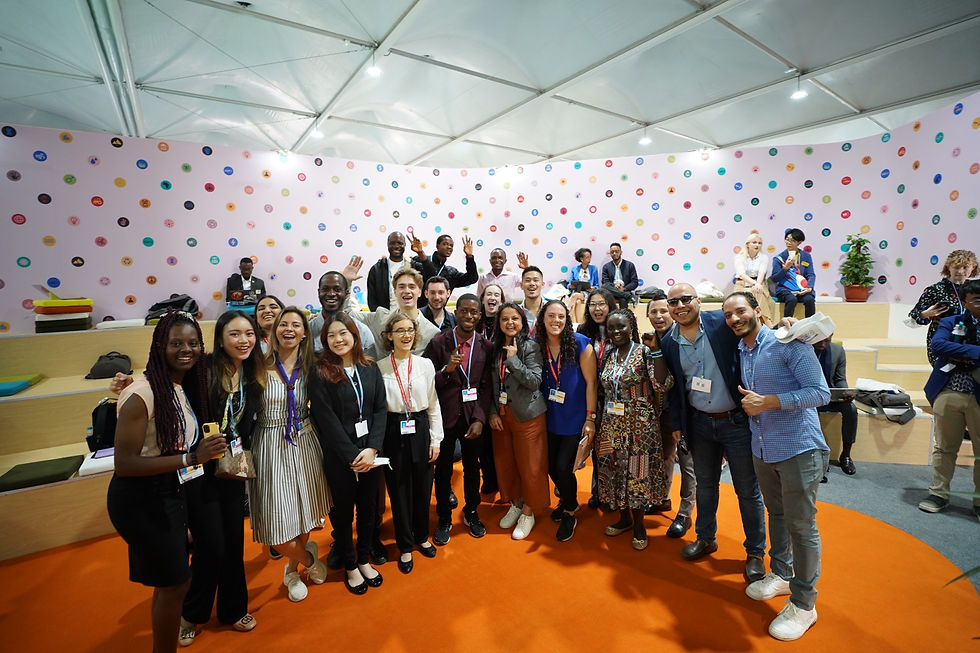Was the COP27 a space of open dialogue?
- Zuzanna Borowska
- Dec 1, 2022
- 4 min read
Inequalities and logistical nightmares

6 November 2022, around 1 a.m. Egyptian time. I have just reached my apartment in one of the huge, half-empty Sharm El-Sheikh holiday resorts, after a whole day of plane travels, one hour of standing in the different pointless queues at the airport, and another 2 hours of waiting for the apartment to get ready in the middle of night. It's the first day of COP27! It's also my first time in Africa and outside of Europe. While trying to fall asleep in the small hot apartment, I realize this will be a difficult session…
This country didn't welcome me as a space open for dialogue or diversity. I saw a reality that scared me at first, where men were clearly superior to women, and where most people would be perfectly fine with going against the rules, just to take advantage of the COP "tourists" and earn more money (special shoutout to the taxi drivers). At the COP venue the situation got a bit better, but not too much. The lack of food at the conference besides grab&go stands and a restaurant demanding 20$ for entry was some kind of disappointment even before we could get any proper disappointments with failed promises.
So I first found COP27 to be a COP of inequalities and logistical nightmares. But… then the negotiations started, the meetings with inspiring people started, and by putting all my efforts in, I tried to help in creating some new open dialogue spaces… and it worked some wonders!

Voices silenced, voices heard
Against all odds, the civil society community at the COP was a huge thing. While difficulties in access to this conference could be clearly seen, those who made it to Egypt coordinated and supported each other like never before. Concerned about their own safety, the climate movement didn't protest too much and didn't shout too much, especially outside the COP venue. However, they found some space for sharing their demands inside, both through civil society actions and through dialogue (!) with the world leaders, negotiators, NGOs, researchers, media, and all the stakeholders who kept running around this huge and chaotic event, slowly finding their ways to make contributions and engage in conversations with others.
The pavilion space spread over a few buildings created just for the conference was mesmerizing at a first glance. Even though most pavilions were dedicated to obvious greenwashing by rich, fossil fuel based countries, there were also some brand new safe spaces available - a civil society pavilion, an education hub, and even a first ever children and youth pavilion where I spent a lot of my time on very insightful and open dialogues with young people, talking strategy and coordination with my dear friends from the ACE Working Group of YOUNGO.
I personally tried to bridge the gap between the negotiations closed to observers and the pavilions closed to negotiators. Did I succeed? Find out in my next posts!

Searching for inclusive spaces
Interestingly, I found one very open space for dialogue inside a negotiating room itself. That was the room where I spent most of my time, one where the negotiations on Action for Climate Empowerment (ACE) took place. Interventions from civil society, a few observers allowed to join closed meetings. A very empathetic and welcoming attitude towards everyone, including first-timer negotiators like myself and representatives of marginalized groups. Direct interactions, open exchange of views, and relationships formed between people representing completely opposite sides of the discussion. And treating everyone in the room as equals which I was not expecting at all and which made many people feel understood and valuable in this dialogue. Of course it was not ideal and could be much better, but my argument here is that this increased involvement of dialogue in the decision-making space (importantly, done without breaking the established rules) was one of the key elements that brought us to an agreement and to a (mostly) satisfying decision, unlike many other rooms that feared change, feared diversity, and feared ambitious decisions. I believe people in those rooms would desperately need more Action for Climate Empowerment, more awareness, and more dialogue.
The Open Dialogues International Foundation team watched all these dynamics closely and we are ready to work on this by engaging in some research on dialogue spaces at international meetings such as COP27, and then cooperating with others to improve the quality of these spaces and participation in them.
Stay tuned!
Still curious to know more about the brilliant concept of ACE, the COP outcomes and the impressions on how it feels to attend the COP in two different roles, one of them being a negotiator for a country located on a different continent? No worries, I've got you covered! Just follow this series and see what happens next!
~Zuzanna Borowska
**ACE, Action for Climate Empowerment - a framework under the UNFCCC (art. 6) and the Paris Agreement (art. 12) which includes 6 elements: education, training, public awareness, public participation, public access to information, and international cooperation.
**YOUNGO (Youth NGOs) - the official Children and Youth Constituency of the UNFCCC.






Comments